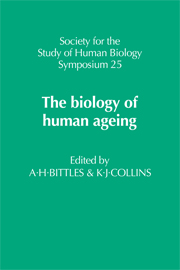Book contents
- Frontmatter
- Contents
- Preface
- Ageing as a consequence of natural selection
- Genetic information in ageing cells
- Insects as models for testing theories of ageing
- Human cell culture systems in the study of ageing
- Estimation of biological maturity in the older child
- Biological age assessment in adulthood
- Skeletal age and palaeodemography
- Cell death and the loss of structural units of organs
- The prospects for mortality decline and consequent changes in age structure of the population
- Where do old people come from? An evaluation of American population projections
- Age structure of Soviet population in the Caucasus: facts and myths
- The health of an ageing population
- Can we tell our age from our biochemistry?
- Dietary manipulation of ageing: an animal model
- Customary physical activity in the elderly
- Effects of ageing on human homeostasis
- Index
Estimation of biological maturity in the older child
Published online by Cambridge University Press: 06 August 2010
- Frontmatter
- Contents
- Preface
- Ageing as a consequence of natural selection
- Genetic information in ageing cells
- Insects as models for testing theories of ageing
- Human cell culture systems in the study of ageing
- Estimation of biological maturity in the older child
- Biological age assessment in adulthood
- Skeletal age and palaeodemography
- Cell death and the loss of structural units of organs
- The prospects for mortality decline and consequent changes in age structure of the population
- Where do old people come from? An evaluation of American population projections
- Age structure of Soviet population in the Caucasus: facts and myths
- The health of an ageing population
- Can we tell our age from our biochemistry?
- Dietary manipulation of ageing: an animal model
- Customary physical activity in the elderly
- Effects of ageing on human homeostasis
- Index
Summary
INTRODUCTION
It is well recognised that chronological age (CA) is a poor measure of maturity (Tanner, 1962). An average-maturing boy completes his growth in stature at 18 years of age whereas an early developer may do so at 15 or 16 years; the late-developer will still be growing as late as 20 years of age. With girls the same is true except that the whole process occurs some two years earlier. In a similar way, an average boy shows the first obvious signs of puberty, genitalia stage 2, at an age of 12 years. In contrast, the earliest developing boy within the normal range will do the same before his tenth birthday and a rather late-developing boy may still show no signs of puberty at the fourteenth birthday. In girls similar situations obtain: the average girl reaches breast stage 2 soon after 11 years of age but the earliest developers may show the same signs by nine years of age and the latest not before the thirteenth birthday. These variations in the progress of maturation introduce a new dimension to the process of growth and development, for which the name ‘tempo’ was coined by Boas (Tanner, 1981). Quantification of tempo requires the use of some measure of maturational progress and it is therefore helpful to explore what methods are available and compare them in terms of their value and validity.
- Type
- Chapter
- Information
- The Biology of Human Ageing , pp. 67 - 80Publisher: Cambridge University PressPrint publication year: 1986
- 1
- Cited by

